2. 西北大学地质学系, 西安 710069
2. Department of Geology, Northwest University, Xi'an 710069, China
四川盆地一直以来被认为是扬子板块内的稳定块体,因此在讨论东亚的板块运动中,常以四川盆地所获得的古地磁极作为拟合扬子板块视极移曲线的重要参考极 (Yang et al., 1992; Liu and Morinaga, 1999; Yang and Bess, 2001; Morinaga and Liu, 2004).然而,在我们的工作中发现从四川东北部地区获得的白垩纪古磁极 (Wang et al., 2013) 与川西同时代的古磁极 (Enkin et al., 1991a) 之间,存在显著的古纬度差 (9.6±5.0°) 这意味着川西与川东北之间可能存在上千公里纬向上的构造运动.同时一些学者 (Otofuji et al., 1990; Enkin et al., 1991a) 也报道过四川盆地古纬度异常问题,Otofuji等(1990) 认为四川盆地在白垩纪时期相对中国大陆块体处于更靠南的位置,还未与中国大陆块体拼合,其白垩纪以来相对中国大陆块体发生500 km的地壳缩短;Enkin等(1991a) 认为四川盆地白垩纪时期的古纬度低于欧亚视极移曲线的期望值,这可能与四川盆地沿秦岭俯冲造成地壳缩短有关.但是,南大巴山平衡剖面得到的大巴山缩短距离约为60~100 km (何建坤等, 1997;董有浦等, 2011),远远达不到前人提出的构造缩短的尺度.此外,将浙东早白垩世 (109~118 Ma) 火山岩古地磁数据 (王非等,2010) 与Wang等(2013)和Enkin等(1991a) 在四川盆地早白垩世陆相碎屑岩中所获得的古地磁数据进行对比,发现古纬度差分别为18.0±6.4°和8.3±5.2°.这些证据表明四川盆地与中国大陆主体和欧亚之间显著的古纬度差很有可能是由于陆相红层中存在的磁倾角偏低造成的.
目前全球各地均有磁倾角偏低现象的报道 (Garcés et al., 1996; Gilder et al., 2003; Rapalini et al., 2006; Tauxe, 2005; Narumoto et al., 2006; Tan et al., 2007; Wang and Yang, 2007; Tauxe et al., 2008; Iosifidi et al., 2010),从这些地区的沉积岩层中测得的古地磁倾角比同时代参考极算得的磁倾角期望值偏低了10°到30°左右.特别是在西藏地区白垩纪-第三纪地层也存在磁倾角偏低现象 (Tan et al., 2010; Huang et al., 2013; Ding et al., 2015),这意味着,在采用来自陆相碎屑岩的古地磁数据为白垩纪-古近纪时期印度板块与欧亚板块碰撞拼合过程提供数据制约的研究中需要进行磁倾角的校正.
对于陆相碎屑岩中磁倾角偏低的成因机制,目前的主要观点包括:(1) 沉积和压实过程造成磁倾角的偏低 (Tauxe and Kent, 2004; Tan et al., 2007);(2) 欧亚大陆的区域地磁场异常 (Chauvin et al., 1996),地磁偶极子场通常叠加有非偶极子场的贡献 (Kent and Smethurst, 1998),或者在异常磁倾角变浅区域之下有一个稳定的非偶极子组分 (Yukutake and Tachinaka, 1968);(3) 亚洲大陆的构造缩短 (Chen et al., 1993; Hankard et al., 2007);(4) 欧亚板块非刚性特征 (Cogné et al., 1999).近年来,一些学者认为中国白垩纪陆相碎屑岩中的磁倾角偏低成因机制主要是沉积压实作用 (Tan et al., 2003;Narumoto et al., 2006; Wang and Yang, 2007),但是Sato等(2011) 提出由于四川盆地沿秦岭俯冲时发生挠曲沉降,沉积地层在倾斜时获得古地磁方向,从而使实测磁倾角偏低.因此,我们在四川盆地的东北部Wang等(2013) 研究区和西部Enkin等(1991a) 的研究区分别采集了古地磁样品,以验证四川盆地内早白垩世红层中是否存在沉积压实作用造成的磁倾角偏低现象.
2 地质背景和古地磁采样四川盆地位于华南板块西北部 (图 1a),是在扬子克拉通台地基础上形成和发展起来的复合型盆地,经历了漫长的地质演化历史,盆地基底由前震旦系变质地层组成 (郭正吾等, 1996;Qiu et al., 2000; Zheng et al., 2006).其长边呈北东-南西向,状若菱形 (图 1b).与其他克拉通盆地相比,四川盆地的特点是其盖层的强烈褶皱和受到不同方向构造挤压变形的改造,在其周缘形成了复杂的弧形褶皱构造带 (张岳桥等, 2011),盆地周围山地环绕,西南部和西侧为龙门山冲断带,南面紧邻川西南褶皱带,东北侧为大巴山弧形构造带 (图 1b).四川盆地为世界上最大的红层盆地之一,大面积分布中生代陆相红层沉积,盆地内红层整体地层倾角较缓 (Li et al., 2016).
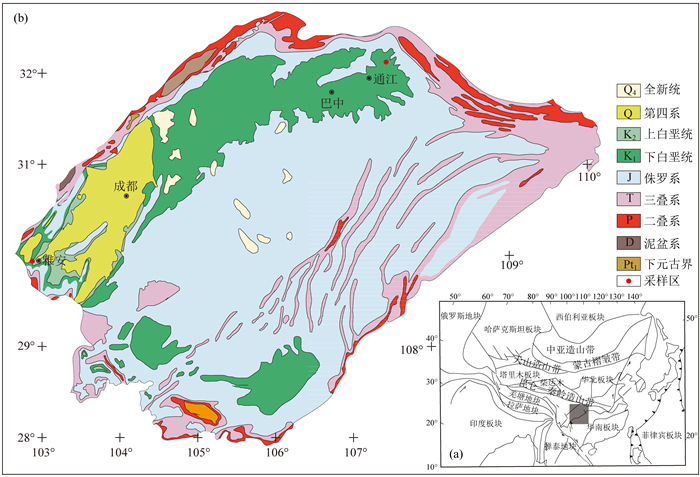
|
图 1 (a) 中国及临区大地构造简图 (修绘自Yang et al., 1992);(b) 四川盆地区域地质简图(修绘自《中国地质图集》) (马丽芳, 2002) Fig. 1 (a) Simplified tectonic map of China and adjacent area (modified from Yang et al., 1992);(b) Geological map of the Sichuan Basin (modified from《Geological Atlas of China》 in Ma, 2002) |
采样剖面分别位于四川盆地东北部巴中市附近 (32.1°N,107.4°E)(图 2)和四川盆地西缘雅安市以西约10 km的飞仙关镇 (30.0°N,102.9°E)(图 3),所采样品均为红色、紫红色粉砂岩,与Enkin等(1991a)和Wang等(2013) 采样区位置、层位和岩性一致.其中,巴中地区的早白垩世地层,自下而上分别为苍溪组、白龙组、七曲寺组、古店组.我们的采样点分布在苍溪组 (图 4a),岩性为灰紫、紫灰、灰绿色厚层块状细至中粒长石砂岩、岩屑长石砂岩,夹薄层砖红、棕红色粉砂岩及泥岩等,产丰富的介形类化石组合Jingguella-Deyangia-Pinnocypridea-Qingjiania及双壳类动物群Trigonioides (Wakinoa)-Nakarmsranaia-Nippononaia-Plicatounio (Plicatounio),该地层属早白垩世早期 (四川省地质矿产勘查开发局,1991).雅安地区的早白垩世地层,下部为天马山组,上部为夹关组.我们的采样地层为天马山组 (图 4b),为一套早白垩世早-中期的棕红、紫红色碎屑岩,上部产介形类化石组合Cypridea (Ulwellia)-Simicypris, 下部产介形类化石组合Jingguella-Deyangia-Pinnocypridea-Qingjiania (四川省地质矿产勘查开发局,1991).

|
图 2 巴中地区1:200000地质简图 (修绘自Wang et al., 2013) Fig. 2 Simplified geological map of Bazhong area (modified from Wang et al., 2013) |
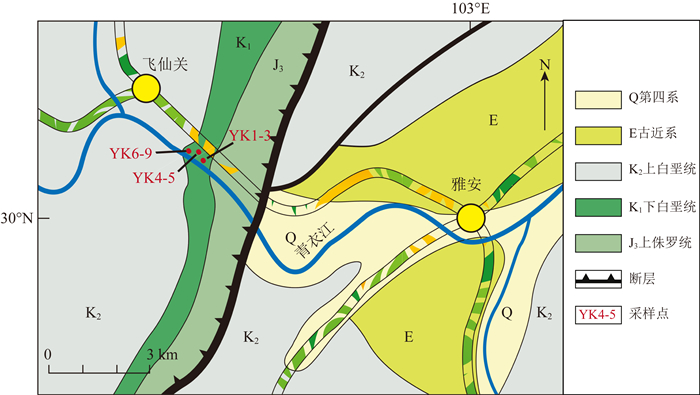
|
图 3 雅安地区采样区地质简图(修绘自Enkin et al., 1991b) Fig. 3 Geological map of Ya′an area (modified from Enkin et al., 1991b) |

|
图 4 野外采样照片 (a) 巴中地区早白垩世苍溪组红色粉砂岩; (b) 雅安地区早白垩世天马山组砖红色粉砂岩. Fig. 4 Photos in the study areas (a) The brick red siltstone of Cangxi Formation in Bazhong area; (b) The red siltstone of Tianmashan Formation in Ya′an area. |
以GPS定位,地质罗盘定向,在巴中和雅安地区分别采集9块定向手标本.并由国际地球参考地磁场 (IGRF) 对采样区现代地磁场偏角进行校正 (巴中:D=-2.8°;雅安:D=-1.7°)(Thébault et al., 2015).
3 测试与分析所有实验工作均在中国地质科学院地质力学研究所国土资源部古地磁与古构造重建重点实验室完成.样品系统热退磁由美制TD-48大型热退磁仪完成,天然剩磁测量在2G-755超导磁力仪上完成,样品的热退磁处理和剩磁测试均在磁屏蔽空间中进行,以避免周围磁场对样品测试数据的影响.利用AGICO KLY-3s Kappabridge进行磁化率各向异性测试.岩石磁学和等温剩磁各向异性实验使用JR6旋转磁力仪测试.在室内从所有定向手标本上,沿垂直岩层层面的方向钻取岩芯288块,并全部加工成高度为20 mm,直径为25 mm的标准岩芯样品.由于Wang等(2013) 已经对巴中地区样品进行了岩石磁学实验,因此仅对雅安地区样品中挑选了代表性样品按照Lowrie (1990) 描述的过程,进行等温剩磁 (IRM) 及三轴等温剩磁热退磁实验 (在X, Y和Z轴方向分别加载强度为0.12 T,0.4 T,2.2 T的磁场),以确定其载磁矿物.最后,在巴中和雅安地区样品中分别选取样品,按照Hodych和Buchan (1994) 描述的过程,进行等温剩磁各项异性 (AIR) 实验.使用主向量分析法进行剩磁组份分析 (Kirschvink, 1980),以手标本为单位进行Fisher统计 (Fisher, 1953).数据的分析处理采用Enkin等(1992)和Cogné (2003) 的软件包.
3.1 岩石磁学结果等温剩磁 (IRM) 及三轴等温剩磁热退曲线实验显示雅安地区样品剩磁强度随外部直流磁场的增大逐步递增,在外加磁场达到2.2 T时样品仍未达到饱和,当所加反向磁场增加至400~500 mT之间时,样品等温剩磁强度减至0 (图 5a),三轴等温剩磁热退磁实验显示解阻温度为680~690 ℃ (图 5b),说明样品以赤铁矿为主要载磁矿物.

|
图 5 雅安地区早白垩世样品 (a)等温剩磁获得曲线; (b) 三轴等温热退磁曲线. Fig. 5 (a) Isothermal remanent magnetization acquisition and opposite field demagnetization curves of red bed sample;(b) Three-component IRM thermal demagnetization curves of red bed sample |
对巴中和雅安地区共92块样品进行了天然剩磁的系统退磁测试,其中仅有9块手标本上的34块样品获得稳定的剩磁方向,样品退磁结果显示双分量的特点 (图 6),低温分量 (LTC) 在300 ℃~400 ℃以下分离出来 (巴中地区以样品为单位进行剩磁平均:倾斜校正前:Dg/Ig=6.3°/54.2°, k=25.0, α95=5.8°;倾斜校正后:Ds/Is=355.0°/57.8°, k=17.8, α95=6.9°)(图 7a, 7b);雅安地区以样品为单位进行剩磁平均:倾斜校正前:Dg/Ig=11.9°/50.3°, k=11.5, α95 =10.0°;倾斜校正后:Ds/Is=346.7°/45.8°, k=15.0, α95=8.7°(图 7c, 7d),在误差范围内,与Enkin等(1991a)和Wang等(2013) 所报道的低温分量方向一致.

|
图 6 代表样品系统热退磁的天然剩磁矢量图 Fig. 6 Representative Zijderveld diagrams of thermal demagnetization of natural remnant magnetism (NRM) from the Early Cretaceous samples (in situ coordinates). Solid circles, horizontal projection; Open circles, vertical projection |
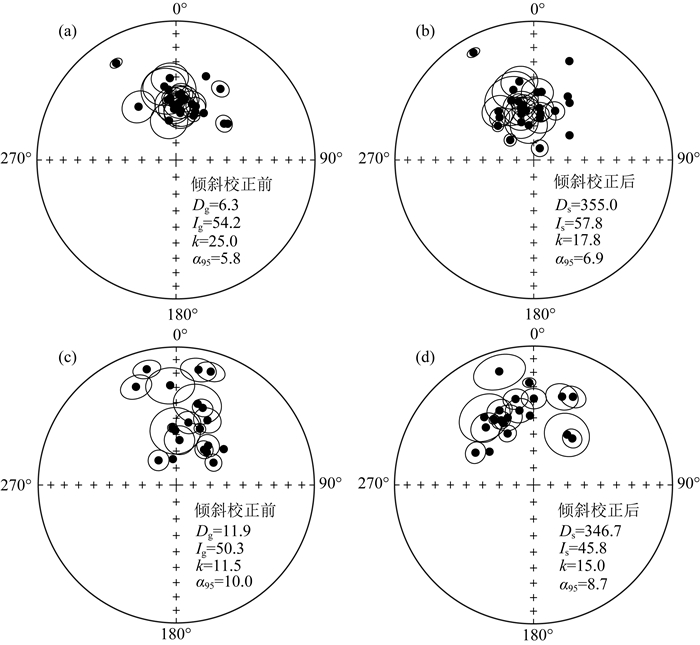
|
图 7 巴中 (a, b) 和雅安地区 (c, d) 以样品为单位统计的低温分量 (LTC) 倾斜校正前后等面积投影图 Fig. 7 Equal-area stereographic projections of low temperature components (LTC) for samples from Bazhong (a, b) and Ya′an (c, d) areas before and after tilt correction |
高温分量于680 ℃~690 ℃解阻,其中巴中地区以样品为单位进行剩磁平均的高温分量方向 (倾斜校正前:Dg/Ig=25.3°/19.0°, k=18.6,α95=8.8°;倾斜校正后:Ds/Is=25.8°/18.9°, k=24.3, α95=7.6°) (图 8a, 8b) 通过了褶皱和倒转检验 (McFadden and McElhinny, 1990;Enkin, 2003),其精密参数获得于100%去褶皱时.这一方向在误差范围内与Wang等(2013) 所报道的特征剩磁方向一致.雅安地区以样品为单位进行剩磁平均的高温分量方向 (倾斜校正前:Dg/Ig=24.5°/45.0°, k=15.7, α95=9.0°;倾斜校正后:Ds/Is=356.7°/35.6°, k=28.5, α95=6.6°)(图 8c, 8d) 虽然未通过褶皱检验和倒转检验,很可能是我们所获数据量偏少的原因,但其在误差范围内与Enkin等(1991a) 所报道的方向一致.
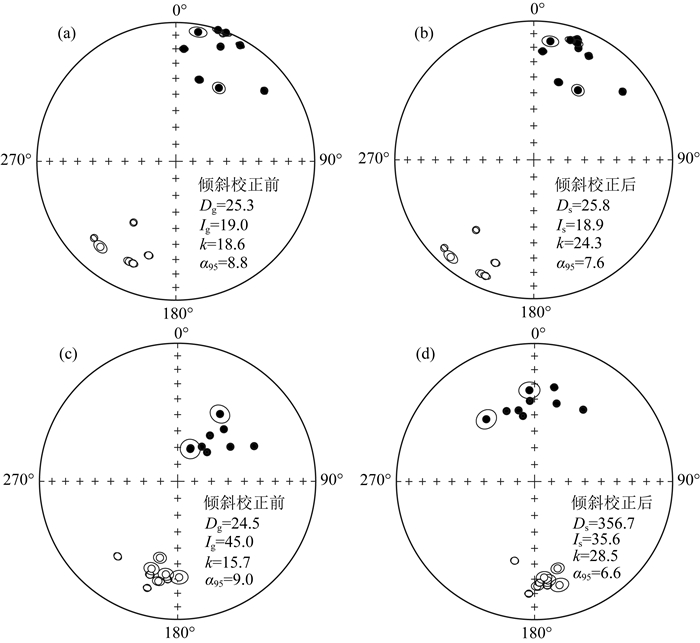
|
图 8 巴中 (a, b) 和雅安 (c, d) 地区以样品为单位统计的高温分量 (HTC) 倾斜校正前后等面积投影图 (实心圆、空心圆分别代表上、下球面投影) Fig. 8 Equal-area stereographic projections of high temperature components (HTC) for samples from Bazhong (a, b) and Ya′an (c, d) areas before and after tilt correction. Lower (upper) hemisphere directions are marked with closed (open) symbols |
共选取207块样品进行磁化率各向异性 (AMS) 测试.一般认为磁组构能够反映岩石所受应力特征 (Graham, 1954; Hroud, 1982; Borradaile and Henry, 1997).两地样品各向异性椭球均显示出扁圆形特征.巴中地区样品在地理坐标下,最大轴K1呈大致南北向分布,最小主轴 (K3) 大致垂直于最大轴和中间轴 (K2) 组成的平面,且呈北东-南西向分布 (图 9a).经地层校正后,最小轴基本垂直地层平面,最大轴 (K1) 及中间轴 (K2) 零散向分布 (图 8c).雅安地区样品在地理坐标下,K1、K2、K3呈现簇状分布特征 (图 9b).经倾斜校正后,K3基本垂直层面, K1轴大致呈NE-SW向分布 (图 9d),与该区褶皱轴NE-SW向一致.前人的研究认为当以赤铁矿为载磁矿物的砂岩受到挤压造成平行层面缩短 (LPS) 或褶皱的压缩应变时,K1轴方向通常垂直于LPS方向或平行于褶皱轴方向 (Saint-Bezar et al., 2002).而平行层缩短的初期,通常产生大致平行层面方向的缩短,导致层面内的磁性矿物朝地层走向方向偏转,形成典型的初始变形磁组构 (Parés et al., 1999;贾东等, 2007;罗良等, 2013;高亮等, 2014).巴中和雅安地区样品测试结果虽然大致呈现这一特点,但两地K1和K2分布均较为分散,整体仍保留沉积磁组构的特征,我们认为两地样品均未经受明显的构造变形影响.
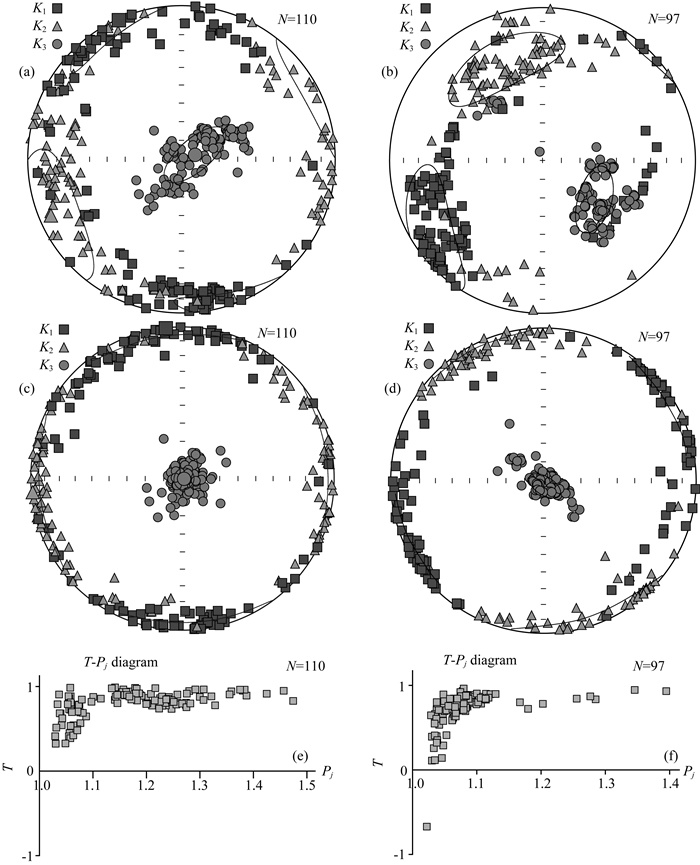
|
图 9 巴中和雅安地区样品磁化率各向异性 (AMS) 数据在地理 (a, b)和地层 (c, d) 坐标下等面积投影图;形状参数 (T) 与各向异性度 (Pj)关系图 (e, f) Fig. 9 Stereographic projection of AMS data in geographic (a, b) and stratigraphic coordinates (c, d) of sample from Bazhong and Ya′an areas, respectively. Plots of shape parameter (T) versus anisotropy degree (Pj) of samples from Bazhong (e) and Ya′an areas (f), respectively. K1=maximum, K2=intermediate, K3=minimum. N is number of samples |
巴中地区样品整体具有较高的磁化率各向异性度 (1.026 < Pj < 1.423)(图 9e).雅安地区除一块手标本样品外 (YK8),整体各向异性度较低 (1.022<Pj<1.131)(图 9f),这与东南沿海褶皱带未发现磁倾角偏低现象的沙县组和崇安组红层得到的结果 (1.008 < Pj < 1.107) 很接近 (Morinaga and Liu, 2004; Narumoto et al., 2006).
3.4 等温剩磁各向异性 (AIR) 结果由于我们所采红层样品中的主要载磁矿物为赤铁矿,为验证是否由沉积压实而造成磁倾角偏低现象,我们从获得稳定剩磁分量的手标本中选取41块样品,应用Hodych和Buchuan (1994) 所描述的步骤进行等温剩磁各向异性 (AIR) 实验.首先沿样品Z轴45°方向连续递增外加磁场以获得平行层面的等温剩磁 (IRMx)和垂直层面的等温剩磁 (IRMz),之后进行热退磁实验.考虑到载磁矿物主要为赤铁矿,且实验过程中样品等温剩磁组份可能会受到的天然剩磁的影响,所以选取外加直流场在200 mT到800 mT之间,以及系统热退磁温度在600 ℃以上的IRMz/IRMx结果进行拟合,结果见表 1.
|
|
表 1 巴中和雅安地区样品等温剩磁各向异性(AIR)数据表 Table 1 Anisotropy of isothermal remanent magnetization for early Cretaceous red beds at Bazhong and Ya′an area, respectively |
当外加磁场在200~800 mT时,巴中地区样品IRMz值明显低于IRMx的值 (图 10a, 10b),且在热退磁过程中IRMz值明显小于IRMx(图 10c).而雅安地区样品在加场阶段IRMz与IRMx值大小基本一致 (图 10d, 10e),在热退过程中IRMz值仅仅稍低于IRMx(图 10f).赤铁矿具有较高的矫顽力,因此我们应用热退磁温度大于600 ℃所获得的IRMz/IRMx拟合平均值进行磁倾角校正.带入公式tan (Iobs)/tan (IF)=IRMz/IRMx,得到巴中和雅安地区校正后的磁倾角分别为22.7°和38.8°.这些结果表明四川盆地早白垩世陆相碎屑岩层中,存在沉积压实作用造成的磁倾角偏低现象,且不同地区表现出不同的压实率,川东北巴中地区的磁倾角偏低程度强于川西雅安地区.
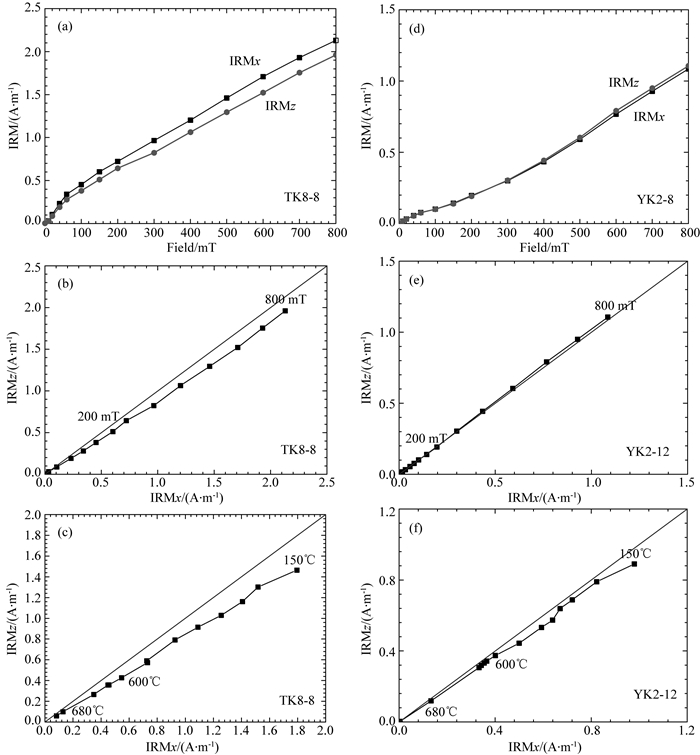
|
图 10 巴中和雅安代表性样品以45°角逐步递增外加磁场过程中,IRMx (平行与地层层面)和IRMz (垂直于地层层面) 对比图 (a, d); 外加磁场强度10~800 mT过程中IRMz/IRMx对比图 (b, e); 热退磁过程中IRMz/IRMx对比图 (c, f) Fig. 10 Plots of IRMx (parallel to bedding) and IRMz (perpendicular to bedding) acquisitions produced by applying magnetic field at 45°to bedding as function of increasing field (a, d). The slope (IRMz/IRMx) of the least\-squares-fit for data points between 200 mT and 800 mT (b, e) is used to estimate the magnetic anisotropy of hematite. The slope of the thermal demagnetization of IRMz and IRMx between 600 ℃ and 680 ℃ (c, f) |
近年来,一些学者认为红层的磁倾角偏低主要是沉积压实作用造成的 (Tan and Kodama, 2002; Tan et al., 2003, 2007; Tauxe and Kent, 2004).磁化率各向异性 (AMS) 可以指示沉积环境,与沉积压实造成的磁倾角偏低现象具有密切联系,沉积相决定了岩石的磁化率各向异性度,层流沉积具有较高的各向异性度,而块体流沉积各向异性度较低,具有较低磁化率各向异性度的样品往往具有较高的磁倾角 (Garcés et al., 1996; Narumoto et al., 2006; Wang and Yang, 2007).巴中地区样品具有较高的各向异度 (1.026 < Pj < 1.423)和较低的磁倾角 (I=18.9°),而雅安地区大部分样品各向异度较低 (1.022<Pj<1.131),具有较高的磁倾角 (I=35.6°).
同时,对四川盆地白垩世地层的研究工作 (王永标和徐海军, 2001;陈竹新等, 2008;隆轲等, 2011;Li et al., 2016) 表明,整体上四川盆地沉降中心在西部和北部呈弧形迁移,在晚侏罗世-早白垩世时期,四川盆地沉降中心在米仓山前.早白垩纪时期,四川盆地东北部的沉积厚度明显大于盆地西部,巴中地区沉积厚度超过1200 m,雅安地区沉积最厚仅为400 m.此时,巴中地区为辫状河沉积,层流更为发育,雅安地区的沉积相在早白垩世早期为辫状河沉积,早白垩世晚期-晚白垩世则变为冲积扇沉积 (Li et al., 2016).正是沉积相的差异造成了两地样品不同的各向异性度,而沉积厚度的不同又使得同一个盆地内存在不同程度的压实作用.
利用我们得到的AIR实验结果对Enkin等(1991a)和Otofuji等(1990) 早白垩世古地磁结果进行了磁倾角校正,并以早白垩世华南平均极 (78.7°N, 215.7°E, A95=8.2°) (Sun et al., 2006) 与之对比,算得的古纬度差分别为6.8±9.2°和2.7±6.4°,在误差范围内古纬度一致.对于Sato等(2011) 提出的挠曲沉降使得实测磁倾角偏低,我们有不同的看法,首先,巴中地区采样点均位于四川盆地内部,采样区的地层产状近水平,并且Wang等(2013) 在该地区获得的古地磁数据通过了褶皱检验和倒转检验,证明是原生的沉积剩磁.而沉积岩在获得原生沉积剩磁后,即使由于构造作用发生同沉积的构造沉降,通过产状校正,获得的剩磁仍为原生时所记录的古地磁场方向,因此Sato等(2011) 提出的模式并不能完全解释四川盆地东北部地区出现的磁倾角偏低现象.结合AIR实验结果,我们认为四川盆地早白垩世红层的古纬度异常是由于沉积压实造成的磁倾角偏低引起.
最后,我们利用E/I检验 (Tauxe and Kent, 2004) 对剩磁数据进行校正.巴中和雅安地区磁倾角校正结果分别为35.0°[20.5, 47.6]和56.8°[36.6, 70.4].由于本次实验获得稳定剩磁分量的数据量偏少,误差范围值较大,因此采用我们以前获得的古地磁数据 (Wang et al., 2013) 进行E/I校正,磁倾角校正结果IEI = 30.5°[24.4, 38.5] (图 11).同时,采用AIR实验获得的数据,对同组数据进行校正的结果为IF=30.4°,与E/I校正的结果非常一致.因此,我们认为沉积压实作用造成了四川盆地早白垩世红层中的磁倾角偏低现象,而且同一个盆地内不同地区的压实程度存在差异.
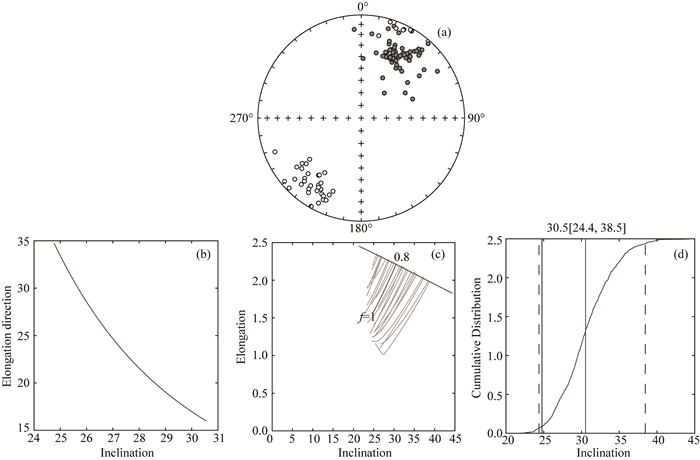
|
图 11 巴中地区古地磁数据(Wang et al., 2013)的E/I校正结果 (a) 特征剩磁等面积投影; (b) 拉长率、磁倾角与浅化率(f)关系; (c) 不同浅化率, (f) 下拉长率和磁倾角关系; (d) 1000套“解靴带”法数据交叉点绘制的分布. Fig. 11 (a) Equal area projection of paleomagnetic direction of samples from Wang et al. (2013); (b) Left: plots of elongation and inclination versus different values of f for Bazhong area;(c) Middle: elongation versus inclination plots for TK03.GAD model and for the paleomagnetic data for different values of f for Bazhong area; (d) The crossing points represent the inclination/ elongation pair most consistent with the TK03.GAD. Right: crossing points from bootstrapped datasets of Bazhong area |
对四川盆地早白垩世红层进行了详细的古地磁学研究,磁化率各向异性研究表明,两地样品均呈现压扁形、初始变形磁组构,但整体仍保留沉积磁组构特征,未经受明显构造应力影响.通过AIR实验显示巴中和雅安地区压实率分别为18%和11%,并计算得到巴中和雅安地区校正后的磁倾角分别为22.7°和38.8°.基于以上结果,我们认为四川盆地早白垩世陆相碎屑岩层中,存在沉积压实作用造成的磁倾角偏低现象,且两地压实作用的差异造成川东北巴中地区的磁倾角偏低程度强于川西雅安地区.
致谢对两位匿名审稿专家提出的建设性意见表示衷心的感谢.
| Borradaile G J, Henry B. 1997. Tectonic applications of magnetic susceptibility and its anisotropy. Earth-Science Reviews, 42(1-2): 49-93. DOI:10.1016/S0012-8252(96)00044-X | |
| Bureau of Geology Mineral Resources of Sichuan Province. Regional Geology of Sichuan Province (in Chinese). Beijing: Geological Publishing House, 1991. | |
| Chauvin A, Perroud H, Bazhenov M L. 1996. Anomalous low palaeomagnetic inclinations from Oligocene-lower Miocene red beds of the south-west Tien Shan, Central Asia. Geophysical Journal International, 126(2): 303-313. DOI:10.1111/gji.1996.126.issue-2 | |
| Chen Y, Cogné J P, Courtillot V, et al. 1993. Cretaceous paleomagnetic results from western Tibet and tectonic implications. Journal of Geophysical Research, 98(B10): 17981-17999. DOI:10.1029/93JB01006 | |
| Chen Z X, Jia D, Wei G Q, et al. 2008. Meso-Cenozoic sediment transport and tectonic transition in the western Sichuan foreland basin. Geology in China (in Chinese), 35(3): 472-481. | |
| Cogné J P, Halim N, Chen Y, et al. 1999. Resolving the problem of shallow magnetizations of Tertiary age in Asia: insights from paleomagnetic data from the Qiangtang, Kunlun, and Qaidam blocks (Tibet, China), and a new hypothesis. Journal of Geophysical Research, 104(B8): 17715-17734. DOI:10.1029/1999JB900153 | |
| Cogné J P. 2003. PaleoMac: a MacintoshTM application for treating paleomagnetic data and making plate reconstructions. Geochemistry, Geophysics, Geosystems, 4(1): 1007. | |
| Ding J K, Zhang S H, Chen W W, et al. 2015. Paleomagnetism of the Oligocene Kangtuo Formation red beds (Central Tibet): Inclination shallowing and tectonic implications. Journal of Asian Earth Sciences, 104: 55-68. DOI:10.1016/j.jseaes.2014.10.006 | |
| Dong Y P, Shen Z Y, Xiao A C, et al. 2011. Construction and structural analysis of regional geological sections of the southern Daba Shan thrust-fold belts. Acta Petrologica Sinica (in Chinese), 27(3): 689-698. | |
| Enkin R J, Courtillot V, Xing L, et al. 1991a. The stationary Cretaceous paleomagnetic pole of Sichuan (South China Block). Tectonics, 10(3): 547-559. DOI:10.1029/90TC02554 | |
| Enkin R J, Chen Y, Courtillot V, et al. 1991b. A Cretaceous pole from south China, and the Mesozoic hairpin turn of the Eurasian apparent polar wander path. Journal of Geophysical Research: Solid Earth, 96(B3): 4007-4027. DOI:10.1029/90JB01904 | |
| Enkin R J, Yang Z Y, Chen Y, et al. 1992. Paleomagnetic constraints on the geodynamic history of the major blocks of China from the Permian to the present. Journal of Geophysical Research: Solid Earth (1978—2012), 97(B10): 13953-13989. DOI:10.1029/92JB00648 | |
| Enkin R J. 2003. The direction-correction tilt test: an all-purpose tilt/fold test for paleomagnetic studies. Earth and Planetary Science Letters, 212(1-2): 151-166. DOI:10.1016/S0012-821X(03)00238-3 | |
| Fisher R. 1953. Dispersion on a sphere. Proceedings of the Royal Society A, 217: 295-305. DOI:10.1098/rspa.1953.0064 | |
| Gao L, Tong Y B, Wang H, et al. 2014. Magnetic fabric study of the Paleocene Ninglang Formation in the Chuandian Fragment and its tectonic implications. Chinese Journal of Geophysics (in Chinese), 57(1): 199-213. DOI:10.6038/cjg20140117 | |
| Garcés M, Parés J M, Cabrera L. 1996. Further evidence for inclination shallowing in red beds. Geophysical Research Letters, 23(16): 2065-2068. DOI:10.1029/96GL02060 | |
| Gilder S, Chen Y, Cogné J P, et al. 2003. Paleomagnetism of Upper Jurassic to Lower Cretaceous volcanic and sedimentary rocks from the western Tarim Basin and implications for inclination shallowing and absolute dating of the M-0 (ISEA?) chron. Earth and Planetary Science Letters, 206(3-4): 587-600. DOI:10.1016/S0012-821X(02)01074-9 | |
| Graham J W. 1954. Magnetic susceptibility anisotropy, an unexploited petrofabric element. Geological Society of America Bulletin, 65: 1257-1258. | |
| Guo Z W, Deng K L, Han Y H, et al. The Formation and Development of Sichuan Basin (in Chinese). Beijing: Geological Publishing House, 1996. | |
| Hankard F, Cogné J P, Kravchinsky V A, et al. 2007. New Tertiary paleomagnetic poles from Mongolia and Siberia at 40, 30, 20, and 13 Ma: clues on the inclination shallowing problem in central Asia. Journal of Geophysical Research, 112: B02101. | |
| He J K, Lu H F, Zhang Q L, et al. 1997. The thrust tectonics and it's transpressive geodynamics in Southern Dabashan Mountains. Geological Journal of China Universities (in Chinese), 3(4): 419-428. | |
| Hodych J P, Buchan K. 1994. Early Silurian palaeolatitude of the Springdale Group redbeds of central Newfoundland: a palaeomagnetic determination with a remanence anisotropy test for inclination error. Geophysical Journal International, 117(3): 640-652. DOI:10.1111/gji.1994.117.issue-3 | |
| Hrouda F. 1982. Magnetic anisotropy of rocks and its application in geology and geophysics. Geophysical Surveys, 5(1): 37-82. DOI:10.1007/BF01450244 | |
| Huang W, Dupont-Nivet G, Lippert P C, et al. 2013. Inclination shallowing in the Eocene Linzizong sediments from Tibet: correction, possible causes and implications for reconstructing the India-Asia collision. Geophysical Journal International, 194(3): 1390-1411. DOI:10.1093/gji/ggt188 | |
| Iosifidi A G, Mac Niocaill C, Khramov A N, et al. 2010. Palaeogeographic implications of differential inclination shallowing in permo-carboniferous sediments from the donets basin, Ukraine. Tectonophysics, 490(3-4): 229-240. DOI:10.1016/j.tecto.2010.05.017 | |
| Jia D, Chen Z X, Luo L, et al. 2007. Magnetic fabrics in fault-related fold and its relation with finite strain: an example from Mingjiang thrust structures in Western Sichuan. Progress in Natural Science (in Chinese), 17(2): 188-195. | |
| Kent D V, Smethurst M A. 1998. Shallow bias of paleomagnetic inclinations in the Paleozoic and Precambrian. Earth and Planetary Science Letters, 160(3-4): 391-402. DOI:10.1016/S0012-821X(98)00099-5 | |
| Kirschvink J L. 1980. The least-squares line and plane and the analysis of palaeomagnetic data. Geophysical Journal International, 62(3): 699-718. DOI:10.1111/gji.1980.62.issue-3 | |
| Li Y Q, He D F, Chen L B, et al. 2016. Cretaceous sedimentary basins in Sichuan, SW China: Restoration of tectonic and depositional environments. Cretaceous Research, 57: 50-65. DOI:10.1016/j.cretres.2015.07.013 | |
| Liu Y Y, Morinaga H. 1999. Cretaceous palaeomagnetic results from Hainan Island in south China supporting the extrusion model of Southeast Asia. Tectonophysics, 301(1-2): 133-144. DOI:10.1016/S0040-1951(98)00216-9 | |
| Long K, Chen H D, Lin L B, et al. 2011. Cretaceous tectonic sequence and litho-paleogeographic evolution in the Sichuan Basin. Journal of Stratigraphy (in Chinese), 35(3): 328-336. | |
| Lowrie W. 1990. Identification of ferromagnetic minerals in a rock by coercivity and unblocking temperature properties. Geophysical Research Letters, 17(2): 159-162. DOI:10.1029/GL017i002p00159 | |
| Luo L, Qi J F, Jia D, et al. 2013. Magnetic fabric investigation in Tianquan-Leshan section in front of Longmenshan fold-thrust belt and its indicative significance for the Cenozoic deformation. Chinese Journal of Geophysics (in Chinese), 56(2): 558-566. DOI:10.6038/cjg20130219 | |
| Ma L F. Geological Atlas of China (in Chinese). Beijing: Geological Publishing House, 2002. | |
| Mcfadden P L, Mcelhinny M W. 1990. Classification of the reversal test in palaeomagnetism. Geophysical Journal International, 103(3): 725-729. DOI:10.1111/gji.1990.103.issue-3 | |
| Morinaga H, Liu Y Y. 2004. Cretaceous paleomagnetism of the eastern South China Block: establishment of the stable body of SCB. Earth and Planetary Science Letters, 222(3-4): 971-988. DOI:10.1016/j.epsl.2004.02.035 | |
| Narumoto K, Yang Z Y, Takemoto K, et al. 2006. Anomalously shallow inclination in middle—northern part of the South China block: palaeomagnetic study of Late Cretaceous red beds from Yichang area. Geophysical Journal International, 164(2): 290-300. DOI:10.1111/gji.2006.164.issue-2 | |
| Otofuji Y, Inoue Y, Funahara S, et al. 1990. Palaeomagnetic study of eastern Tibet-deformation of the Three Rivers region. Geophysical Journal International, 103(1): 85-94. DOI:10.1111/gji.1990.103.issue-1 | |
| Parés J M, van der Pluijm B V, Dinarès-Turell J. 1999. Evolution of magnetic fabrics during incipient deformation of mudrocks (Pyrenees, Northern Spain). Tectonophysics, 307(1-2): 1-14. DOI:10.1016/S0040-1951(99)00115-8 | |
| Qiu Y M, Gao S, McNaughton N J, et al. 2000. First evidence of > 3.2Ga continental crust in the Yangtze craton of south China and its implications for Archean crustal evolution and Phanerozoic tectonics. Geology, 28(1): 11-14. DOI:10.1130/0091-7613(2000)028<0011:FEOGCC>2.0.CO;2 | |
| Rapalini A E, Fazzito S, Orué D. 2006. A new Late Permian paleomagnetic pole for stable South America: The Independencia group, eastern Paraguay. Earth, Planets and Space, 58(10): 1247-1253. DOI:10.1186/BF03352620 | |
| Saint-Bezar B, Hebert R L, Aubourg C, et al. 2002. Magnetic fabric and petrographic investigation of hematite-bearing sandstones within ramp-related folds: examples from the South Atlas Front (Morocco). Journal of Structural Geology, 24(9): 1507-1520. DOI:10.1016/S0191-8141(01)00140-7 | |
| Sato S, Yang Z Y, Tong Y B, et al. 2011. Inclination variation in the Late Jurassic to Eocene red beds from southeast Asia: lithological to locality scale approach. Geophysical Journal International, 186(2): 471-491. DOI:10.1111/j.1365-246X.2011.05030.x | |
| Sun Z M, Yang Z Y, Yang T S, et al. 2006. New Late Cretaceous and Paleogene paleomagnetic results from south China and their geodynamic implications. Journal of Geophysical Research, 111(B3): B03101. | |
| Tan X D, Kodama K P. 2002. Magnetic anisotropy and paleomagnetic inclination shallowing in red beds: Evidence from the Mississippian Mauch Chunk Formation, Pennsylvania. Journal of Geophysical Research, 107(B11): EPM 9-1-EPM 9-17. DOI:10.1029/2001JB001636 | |
| Tan X D, Kodama K P, Chen H L, et al. 2003. Paleomagnetism and magnetic anisotropy of Cretaceous red beds from the Tarim basin, northwest China: Evidence for a rock magnetic cause of anomalously shallow paleomagnetic inclinations from central Asia. Journal of Geophysical Research, 108(B2): 2107. | |
| Tan X D, Kodama K P, Gilder S, et al. 2007. Rock magnetic evidence for inclination shallowing in the Passaic Formation red beds from the Newark basin and a systematic bias of the Late Triassic apparent polar wander path for North America. Earth and Planetary Science Letters, 254(3-4): 345-357. DOI:10.1016/j.epsl.2006.11.043 | |
| Tan X D, Gilder S, Kodama K P, et al. 2010. New paleomagnetic results from the Lhasa block: Revised estimation of latitudinal shortening across Tibet and implications for dating the India—Asia collision. Earth and Planetary Science Letters, 293(3-4): 396-404. DOI:10.1016/j.epsl.2010.03.013 | |
| Tauxe L, Kent D V. 2004. A simplified statistical model for the geomagnetic field and the detection of shallow bias in paleomagnetic inclinations: was the ancient magnetic field dipolar?.// Timescales of the Paleomagnetic Field. Washington, D.C.: American Geophysical Union, 101-115. | |
| Tauxe L. 2005. Inclination flattening and the geocentric axial dipole hypothesis. Earth and Planetary Science Letters, 233(3-4): 247-261. DOI:10.1016/j.epsl.2005.01.027 | |
| Tauxe L, Kodama K P, Kent D V. 2008. Testing corrections for paleomagnetic inclination error in sedimentary rocks: A comparative approach. Physics of the Earth and Planetary Interiors, 169(1-4): 152-165. DOI:10.1016/j.pepi.2008.05.006 | |
| Thébault E, Finlay C C, Beggan C D, et al. 2015. International Geomagnetic Reference Field: the 12th generation. Earth, Planets and Space, 67: 79. DOI:10.1186/s40623-015-0228-9 | |
| Wang B, Zhang G W, Yang Z Y. 2013. New Mesozoic paleomagnetic results from the northeastern Sichuan basin and their implication. Tectonophysics, 608: 418-427. DOI:10.1016/j.tecto.2013.09.005 | |
| Wang B, Yang Z Y. 2007. Late Cretaceous paleomagnetic results from southeastern China, and their geological implication. Earth and Planetary Science Letters, 258(1-2): 315-333. DOI:10.1016/j.epsl.2007.03.045 | |
| Wang F, Yang L K, Wang L, et al. 2010. The boundary ages of the late Mesozoic volcanic-sedimentary strata on South China: Constrains from 40Ar/39Ar geochronology and paleomagnetism. Scientia Sinica Terrae (in Chinese), 40(11): 1552-1570. | |
| Wang Y B, Xu H J. 2001. Relations between evolution of sedimentary cycles and tectonic uplift around Sichuan Basin from Jurassic to early Cretaceous. Earth Science-Journal of China University of Geosciences (in Chinese), 26(3): 241-264. | |
| Yang Z Y, Courtillot V, Besse J, et al. 1992. Jurassic paleomagnetic constraints on the collision of the North and South China Blocks. Geophysical Research Letters, 19(6): 577-580. DOI:10.1029/91GL02416 | |
| Yang Z Y, Bess J. 2001. New Mesozoic apparent polar wander path for south China: tectonic consequence. Journal of Geophysical Research, 106(B5): 8493-8520. DOI:10.1029/2000JB900338 | |
| Yukutake T, Tachinaka H. 1968. 52. The westward drift of the geomagnetic secular variation. Bulletin of the Earthquake Research Institute, University of Tokyo, 46(5): 1075-1102. | |
| Zhang Y Q, Dong S W, Li J H, et al. 2011. Mesozoic multi-directional compressional tectonics and formation-reformation of Sichuan basin. Geology in China (in Chinese), 38(2): 233-250. | |
| Zheng J P, Griffin W L, O'Reilly S Y, et al. 2006. Widespread Archean Basement beneath the Yangtze Craton. Geology, 34(6): 417-420. DOI:10.1130/G22282.1 | |
| 陈竹新, 贾东, 魏国齐, 等. 2008. 川西前陆盆地中—新生代沉积迁移与构造转换. 中国地质, 35(3): 472–481. | |
| 董有浦, 沈中延, 肖安成, 等. 2011. 南大巴山冲断褶皱带区域构造大剖面的构建和结构分析. 岩石学报, 27(3): 689–698. | |
| 高亮, 仝亚博, 王恒, 等. 2014. 川滇地块古新统宁蒗组磁组构特征及构造意义. 地球物理学报, 57(1): 199–213. DOI:10.6038/cjg20140117 | |
| 郭正吾, 邓康岭, 韩永辉, 等. 四川盆地形成与演化. 北京: 地质出版社, 1996. | |
| 何建坤, 卢华复, 张庆龙, 等. 1997. 南大巴山冲断构造及其剪切挤压动力学机制. 高校地质学报, 3(4): 419–428. | |
| 贾东, 陈竹新, 罗良, 等. 2007. 断层相关褶皱的磁组构与有限应变:川西岷江冲断构造的实例分析. 自然科学进展, 17(2): 188–195. | |
| 隆轲, 陈洪德, 林良彪, 等. 2011. 四川盆地白垩纪构造层序、岩相古地理及演化. 地层学杂志, 35(3): 328–336. | |
| 罗良, 漆家福, 贾东, 等. 2013. 龙门山南段山前天全—乐山剖面磁组构研究及其对新生代构造变形的指示意义. 地球物理学报, 56(2): 558–566. DOI:10.6038/cjg20130219 | |
| 马丽芳. 中国地质图集. 北京: 地质出版社, 2002. | |
| 四川省地质矿产勘查开发局. 四川省区域地质志. 北京: 地质出版社, 1991. | |
| 王非, 杨列坤, 王磊, 等. 2010. 中国东南晚中生代火山沉积地层界线时代-40Ar/39Ar年代学及磁性地层研究. 中国科学:地球科学, 40(11): 1552–1570. | |
| 王永标, 徐海军. 2001. 四川盆地侏罗纪至早白垩世沉积旋回与构造隆升的关系. 地球科学:中国地质大学学报, 26(3): 241–264. | |
| 张岳桥, 董树文, 李建华, 等. 2011. 中生代多向挤压构造作用与四川盆地的形成和改造. 中国地质, 38(2): 233–250. | |
 2017, Vol. 60
2017, Vol. 60


